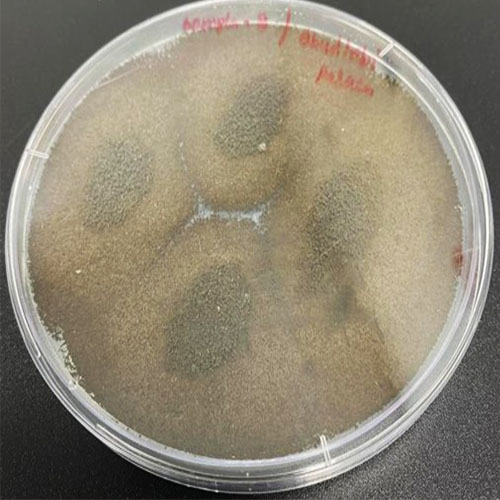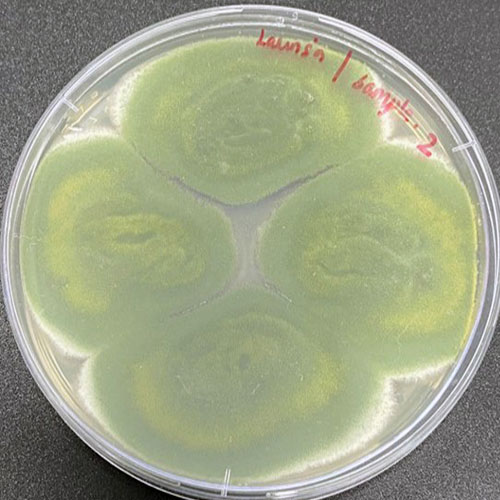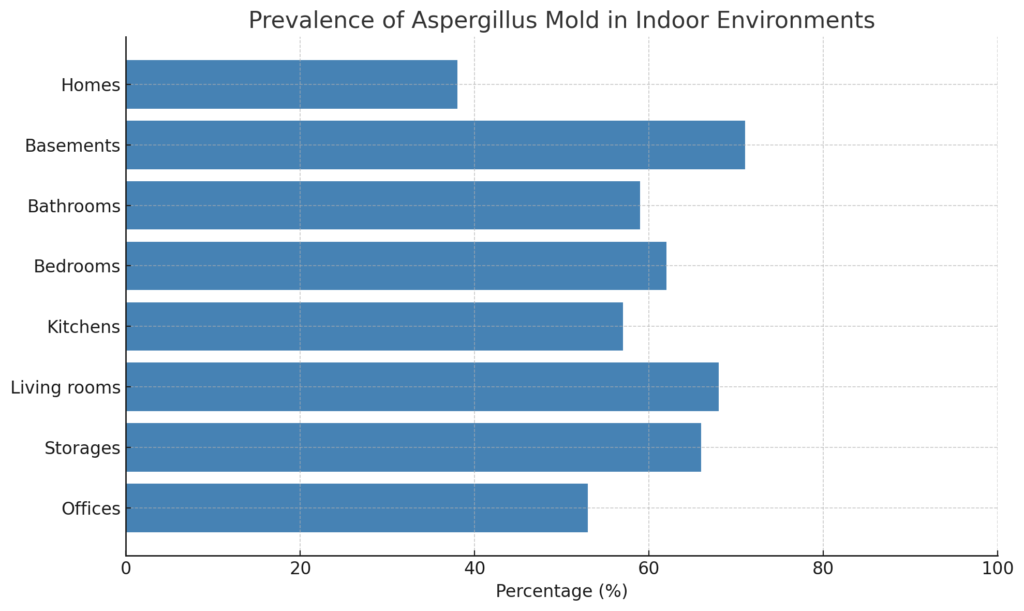Aspergillus is a highly diverse genus of fungi known for its significant economic, ecological, and health-related impacts. Due to its remarkable ability to thrive in elevated temperatures and low-moisture conditions, Aspergillus species are among the most prevalent agents of food spoilage worldwide. These fungi primarily reproduce asexually and are commonly found in various food products and raw materials. Aspergillus species often coexist and compete with other fungi, such as Penicillium and Fusarium. Despite their association with spoilage, Aspergillus fungi also play beneficial roles in biotechnology, food production, and medicine. However, some species are pathogenic, leading to infections in plants, animals, and humans.
Colonies of Aspergillus species typically grow rapidly and exhibit colors ranging from white and yellow to brown and green. The colony surface consists of a dense mat of spore-bearing structures called conidiophores, which emerge from a specialized cell termed a footcell. At the tips of conidiophores are vesicles, spherical or slightly elongated structures that give rise to spore-producing cells.
Depending on the species, vesicles may be surrounded by a single layer of phialides (uniseriate) or an additional layer of metulae, making them biseriate. Both phialides and metulae produce conidia (asexual spores), which appear in dry chains that either spread outward or form compact columns. Conidia vary in texture (smooth or rough) and pigmentation and are crucial for the fungus’s reproduction and dispersion. Some species also produce survival structures, such as Hülle cells and sclerotia, to endure harsh environmental conditions.


Aspergillus species are ubiquitous and thrive across a wide range of ecosystems and climates, including soil, water, and agricultural environments. They are also present in extreme conditions, such as salt marshes and Antarctic regions. Species like Aspergillus fumigatus and A. terreus can be pathogenic, causing infections and producing harmful mycotoxins. On the other hand, species such as A. niger, A. oryzae, and A. aculeatus are valued in various industries for producing enzymes, organic acids, and fermented food products. This versatility has made Aspergillus a focal point of scientific research and a significant player in global economics and health.
In the United Arab Emirates (UAE), Aspergillus mold is particularly prevalent due to the region’s hot and humid climate, which provides an ideal environment for fungal growth. Aspergillus is commonly found in areas with poor ventilation, air conditioning systems, and water-damaged structures. Buildings, especially older ones, that experience condensation issues or plumbing leaks are at higher risk for mold growth.
The combination of high indoor humidity levels and dust accumulation in UAE homes and offices creates an environment conducive to Aspergillus proliferation. Common locations include bathrooms, kitchens, basements, and HVAC systems, where moisture is consistently present. Aspergillus species such as A. niger and A. flavus are frequently detected, posing health risks like respiratory irritations, allergies, and asthma exacerbation.
Additionally, workplaces with inadequate maintenance of air conditioning units and filtration systems are susceptible to mold infestations. Regular inspections, dehumidification, and air quality assessments are essential in preventing Aspergillus contamination in indoor spaces across the UAE.
The genus Aspergillus was first described in 1729 by Pier Antonio Micheli, who noted that the conidiophores resembled an aspergillum, a tool used to sprinkle holy water in Christian ceremonies. Aspergillus is a large genus comprising approximately 300 species, which are classified into six subgenera based on genetic, morphological, and physiological characteristics:
These subgenera are further linked to their sexual states, with related genera including Eurotium, Fennellia, Petromyces, and Emericella.
– Aspergillus niger: Commonly found in soil and decaying organic matter, this species is a key source of industrial enzymes.
– Aspergillus flavus: Found in soil and decaying wood, it produces aflatoxins and can cause severe health issues, including liver cancer, immune suppression, and stunted growth.
– Aspergillus fumigatus: A plant saprophyte that can infect immunocompromised individuals, leading to invasive aspergillosis.
– Aspergillus oryzae: Traditionally used in the fermentation of soy and rice products.
Aspergillus fungi produce metabolites, which are biologically active compounds vital for their survival. These metabolites are divided into two types:
– Primary metabolites: Essential for growth, development, and reproduction.
– Secondary metabolites: Non-essential for survival but highly versatile, with applications in pharmaceuticals, agriculture, and biotechnology.
Polyketides, a major class of fungal secondary metabolites, are particularly important. They include antibiotics like erythromycin and cholesterol-lowering agents such as lovastatin. However, some Aspergillus species produce harmful polyketides, like aflatoxins and ochratoxins, which pose serious health risks.
Industries rely on Aspergillus, especially A. niger, for enzyme production. These enzymes have wide-ranging applications:
Aflatoxins were first discovered during the 1960s after a poultry outbreak caused by contaminated peanut feed. These toxins are produced primarily by Aspergillus flavus and are known for their resilience to heat and cold. Aflatoxins are carcinogenic, mutagenic, and immunosuppressive, with long-term exposure linked to liver damage and cancer.
Ochratoxins, another group of harmful secondary metabolites, are produced by species such as A. ochraceus and A. niger. They commonly contaminate food products like grains, coffee, and dried fruits and are associated with kidney damage, congenital disabilities, and potential carcinogenicity.
Interestingly, theories suggest that ochratoxins may have contributed to the “Egyptian mummy” curse, where archaeologists experienced unexplained deaths, potentially due to fungal spore inhalation.
Aspergillus mold is frequently found indoors, particularly in water-damaged buildings. The U.S. Environmental Protection Agency developed the Environmental Relative Moldiness Index (ERMI) to assess mold contamination in homes. Of the 36 mold species monitored, 10 belong to the Aspergillus genus, including A. flavus, A. fumigatus, A. niger, and A. versicolor. These molds are linked to respiratory issues, asthma, and severe conditions such as invasive aspergillosis.
Indoor air quality data shows that Aspergillus spores are among the most commonly detected molds in buildings with elevated mold levels. Their prevalence underscores the importance of monitoring and mitigating mold growth to protect human health.

Consult our experts:


I combine my love of food and storytelling to create beautiful photos.